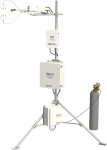
Fundamentals of Carbon Flux Systems

What is a carbon flux system?
A carbon flux system is an integrated system of components used to measure, record, and process the carbon dioxide (CO2) or methane (CH4) exchange between the biosphere and atmosphere in the surface layer of the atmosphere. These systems are used over different land types (such as forests, grasslands, crops, and shrubs) across the globe to provide information needed for management and research purposes. Carbon flux systems that offer a rugged design, low power requirement, low maintenance, and network monitoring software can operate remotely for long periods without the need for expensive site visits.
Note: Similar terms to describe “carbon flux systems” may include “CO2 flux,” “carbon dioxide flux,” “GHG flux,” “greenhouse gas flux,” “eddy covariance,” “CH4 flux,” and “methane flux.”
How does a carbon flux system work?
The carbon flux systems offered by Campbell Scientific measure the carbon exchange between the biosphere and atmosphere using the eddy-covariance technique. This technique relies on a high-resolution, fast-response 3-D sonic anemometer, as well as a fast-response gas analyzer, data logger, and flux processing program.
In some ecosystems, profile measurements of carbon dioxide, water vapor, and temperature are measured, and a carbon storage flux term is identified.
What are the different components of a carbon flux system?
A typical carbon flux system, using the eddy-covariance technique, comprises a variety of components, including the following:
- High-resolution, fast-response 3-D sonic anemometer
- Fast-response gas analyzer
- Storage flux system
- Data logger
- Flux processing program
- Surface energy balance sensors
- Ancillary biometeorology sensors
- Mounting structures
- Remote communications
3-D sonic anemometer

A 3-D sonic anemometer (such as Campbell Scientific’s CSAT3B, CSAT3A, or IRGASON®) measures three orthogonal wind components and the speed of sound by determining the time of flight of sound between three pairs of transducers. In a carbon flux system, the turbulent fluctuations of vertical wind measured by the 3-D sonic anemometer are used in conjunction with an infrared gas analyzer to estimate the magnitude and direction of CO2 exchange. This instrument must have adequate frequency response to capture small eddies in the atmosphere. All of Campbell Scientific’s sonic anemometers have adequate frequency response to be used in carbon flux systems.
Gas analyzer

A gas analyzer in a carbon flux system measures the scalar component of the flux. Campbell Scientific’s gas analyzers for measuring CO2 exchange (IRGASON®, EC150 and EC155) are non-dispersive mid-infrared (NDIR) absorption analyzers. A source of infrared radiation is passed along an optical path to a detector. Interference filters are used to filter light wavelengths that correspond to CO2 absorption and CO2 transmittance. Thus, the dual wavelength nature of the analyzers provides both a reference and sample reading without the need for a separate reference cell and detector.
Rather than using NDIR, a tunable diode laser is used (TDL) to measure CH4 exchange. Lasers used in Campbell Scientific’s TGA200A analyzer are interband cascade lasers (ICL) and can be chosen for target wavelengths between 3 to 6 µm. This mid-infrared range captures where many important trace gases have their peak absorption (CO2, N2O, and CH4).
Gas analyzers used for measuring carbon flux with the eddy-covariance method must be aerodynamic and sample fast enough to resolve small eddies.
- At Campbell Scientific, we have designed our open-path gas analyzers to be aerodynamic and minimize flow distortion compared to other designs that place a large bluff-bodied gas analyzer adjacent to the sampling volume of the sonic anemometer.
- The closed-path design also minimizes flow distortion by minimizing the size of the sample intake and inlet.
Gas analyzers must also be able to respond rapidly to small eddies in the atmosphere. The IRGASON®, EC150, EC155, and TGA200A all have adequate frequency response to be used in carbon flux systems.
Note: The EC155 is ordered as part of a CPEC300, CPEC306, or CPEC310 system.
Storage flux system
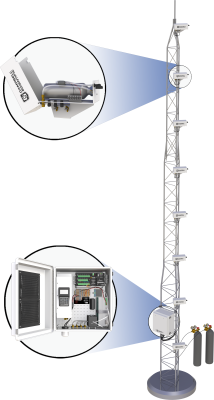
During periods of little to no turbulence, especially during the night, there can be a significant contribution of the flux that cannot be captured by the gas analyzer and sonic anemometer listed above. The lack of turbulence causes a gradient buildup of CO2 that is not transported by eddies into the sensing volume of the instruments. This gradient remains until the sun rises and turbulence is restored. The result of the above cycle results in apparent periods of little to no flux followed by a large contribution to the flux. With a profile system, such as Campbell Scientific’s AP200, a gradient of CO2 flux can be measured with a slower response gas analyzer, such as the LI-840A (LI-COR Biosciences, Lincoln NE) and several intakes. This gradient can then be integrated over time, with a storage flux term calculated and added to the daily flux total. The result is a more accurate CO2 flux and better estimation of net ecosystem exchange (NEE).
Data Logger
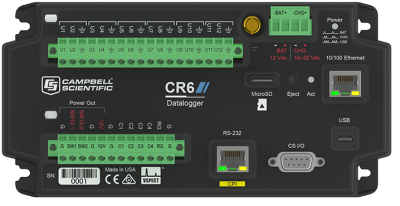
In almost all applications, Campbell Scientific carbon flux systems operate in conjunction with a data logger (that is, the CR3000, CR6, CR1000, or CR1000X).
- For the open-path carbon flux systems and closed-path CH4 flux system, the data logger is used to do the following:
- Store the raw data.
- Process the raw data and store fluxes.
- Allow for remote communications to the station.
- Provide diagnostic information about the system.
- For the closed-path CO2 flux systems, in addition to those functions listed above, the data logger also provides the control for the pump flow and valve switching (for zero/span calibration).
- For the storage flux system, the data logger provides all the same functions listed above for the open-path system and additionally controls the valve switching and timing for the profile gradient measurements.
Flux processing program

The data loggers used with Campbell Scientific carbon flux systems require a program for data storage and system operation. For the open- and closed-path carbon flux system, this program is provided as part of our EasyFlux® DL offering. EasyFlux® DL is a CRBasic program that enables the data logger to report fully corrected carbon fluxes processed from raw high frequency time series data by applying commonly used corrections found in scientific literature. Additionally, this program stores diagnostic and calibration information.
For the storage flux system, a program is provided that offers system control, diagnostic and calibration information storage, and profile site concentration averages that can be used to calculate a daily storage value.
Surface energy balance sensors

Carbon flux systems are often equipped with additional sensors to measure the surface energy balance. The surface energy balance consists of the net radiation (Rn), soil heat flux (G), latent heat flux (LE), and sensible heat flux (H). A CNR4-L, NR01-L, or NR-LITE2-L (from Campbell Scientific) is used to measure the net radiation. In a Campbell Scientific carbon flux system, HFP01-L or HFP01SC-L heat flux plates are used with CS616 or CS65(x) water content reflectometers and TCAV-L averaging thermocouples to calculate the ground heat flux. The gas analyzer and sonic anemometer provide carbon flux measurements for the latent and sensible heat flux. When an examination of the surface energy balance is performed, it checks for a conservation of energy and can provide estimates of flux reliability or bias in the measurements.
Biometeorology sensors

In conjunction with the surface energy balance sensors discussed in the previous section, additional biometeorology sensors are often used with the carbon flux system. In a Campbell Scientific carbon flux system, these include temperature and relative humidity probes (such as the HMP155A-L or EE181-L), rain gages (such as the TE525-L), and infrared leaf radiometers (such as the SI-111). Data from these sensors are important for gap filling carbon flux data and for understanding environmental conditions.
Mounting structures
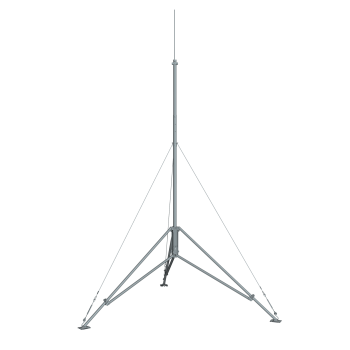
Campbell Scientific offers tripods and towers for mounting carbon flux systems ranging in height from 2 to 9 m. These offerings include the CM106B, CM110, CM120, UT10, UT20, and UT30.
Note: Consideration of the flux footprint must be taken into account when determining placement of the instruments.
Remote communications

Cellular, radio, or satellite telemetry can be used for remote communications to carbon flux systems. This can allow for data monitoring as well as data transfer of fully processed fluxes. Moreover, with the addition of EasyFlux® Web, it is easier to monitor institution networks of remote carbon flux systems from anywhere in the world.
How do carbon flux systems differ from each other?
Carbon flux systems can be compared and contrasted on several different levels, but the following are some primary characteristics that may be helpful for you to be mindful of:
- Quality
- Eddy-covariance approach
- Colocation of carbon flux measurements
Quality
Campbell Scientific is known for its high-quality data loggers that operate in some of the harshest environmental conditions experienced on earth. These data loggers are at the heart of our carbon flux systems. Additionally, Campbell Scientific also offers field-rugged, robust analyzers to make carbon flux measurements. Our low-power CO2 analyzers are optimized to be used confidently on remote solar panel systems while keeping biases such as heat generated by the gas analyzer out of the measurement. The Campbell Scientific CH4 analyzer provides extremely low noise (based on a 100 ms Allan deviation) and is designed to be used without the need for a cumbersome instrumentation shed. Finally, our CSAT sonic anemometer is designed with small-diameter transducers at optimized path lengths set at 60 degrees from horizontal to minimize transducer-induced shadowing effects on turbulence measurements. The CSAT also includes an optional correction for instances when wind blows parallel to the transducer path length.
Eddy-covariance approaches
The eddy-covariance technique is commonly used for carbon flux measurements in the form of carbon dioxide. There are, however, two different approaches that may be employed: open path or closed path.
- The open-path approach to measuring carbon flux uses gas analyzers that measure the absorption of an infrared beam that is propagated through the atmosphere from a source to a detector.
- The closed-path approach measures the gas within an enclosed sample by using a pump to pull the air through the sample cell.
Naturally, each approach has its advantages and disadvantages.
Closed-path systems
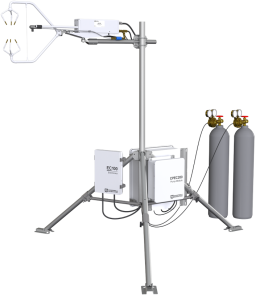
The following are some advantages of closed-path systems:
- These systems measure both temperature and pressure in the path that the gas measurement is made, eliminating the need to correct for density effects on the carbon flux measurement.
- Closed-path systems allow for automated calibration checks and procedures using known standards.
- Because the measurement of the gas occurs within an enclosed sample cell, adverse weather conditions typically do not affect instrument performance.
Closed-path systems have the following disadvantages:
- These systems have higher power requirements because of the sample pump.
- As the sampling lines become contaminated, there is a degraded frequency response.
- Lag time corrections are needed.
Open-path systems

The following are some advantages of open-path systems:
- These systems do not include sampling lines, so they typically have a higher frequency response.
- Open-path systems do not require tubing or pumps, which can simplify installation of the instrument.
- These systems do not use a pump, so the power requirement is less.
Open-path systems have the following disadvantages:
- Because they are exposed to the atmosphere, inclement weather can cause increased data gaps.
- Open-path systems typically do not have temperature and pressure measurements in the measurement path. Therefore, they require corrections for density effects on the carbon flux.
Colocation of carbon flux measurements
Measurement instruments used in carbon flux systems may or may not have integrated sensors to make colocated measurements.
A truly colocated design avoids flux loss due to spatial separation, which becomes more important the closer to the surface the instrument is located. In addition, a colocated design provides a sonic temperature in the path of the gas measurement, allowing for a carbon flux to be calculated based on a point-by-point mixing ratio.
An instrument with a fixed separation between the sonic anemometer and the gas analyzer eliminates any wind flow distortion effects caused by the analyzer housing at large angles of attack. An instrument with this type of spatial separation, however, requires a correction factor to account for the flux loss, as well as a density correction on carbon fluxes because there is no longer a sonic temperature measurement in the gas measurement path.
How do you select the carbon flux system that is right for your application?
Selecting a carbon flux system is an important decision that requires careful consideration. For assistance with the selection process, review the detailed Purchase Considerations section.
Purchasing Considerations for Carbon Flux Systems
Need a "family" image of the IRGASON, CPEC306, AP200, and TGA200A.
To assess the various carbon flux systems available to you and ultimately determine which system is the most suitable, you should first identify your application's needs and requirements. If necessary, review any related documentation, permits, or regulations. Your familiarity with these items will help ensure that the system you select will meet your compliance requirements.
Note: The considerations discussed here do not constitute an all-inclusive list but serve to provide common considerations that have been helpful to our customers in guiding them through the selection process.
Gas Species of Interest
Determining which gas species are critical to the carbon flux at your site will help determine which instruments are needed in the system.
| Carbon dioxide and methane | Determine whether you require measurements of carbon flux in the form of carbon dioxide with or without the addition of methane. Environmental conditions, soil temperature, and soil water content all greatly contribute to the production and consumption of methane. Therefore, they are important considerations when determining which gases to measure. |
| Eddy-covariance approach |
Determine whether you require an open-path or closed-path approach.
|
| Colocated measurements |
If an open-path approach is chosen, determine whether measurements of wind speed and scalar gas need to be colocated.
|
- For measurements of carbon flux in the form of methane, Campbell Scientific offers the TGA200A Trace Gas Analyzer with the CSAT3B 3-D Sonic Anemometer.
- For measurements of carbon flux in the form of carbon dioxide, Campbell Scientific offers open-path sensors, such as the IRGASON® (Integrated CO2 and H2O Open-Path Gas Analyzer and 3-D Sonic Anemometer) or the EC150 (CO2/H2O Open-Path Gas Analyzer) with the CSAT3A (3-D Sonic Anemometer).
- For measurements requiring a separate gas analyzer and sonic anemometer, Campbell Scientific offers the CSAT3A 3-D Sonic Anemometer and the EC150 CO2/H2O Open-Path Gas Analyzer.
Ecosystem for Measuring Carbon Flux
The ecosystem in which the carbon flux is being measured may help determine the additional need of the storage flux component. In ecosystems with tall vegetation and during periods of low turbulence, there may be a significant portion of CO2 buildup that is not measured by the open- or closed-path gas analyzer and sonic anemometer.
| Gas concentration buildup |
The storage flux term is a vertical integral of time derivative concentration measurements of carbon dioxide, water vapor, and temperature that needs to be measured during periods of little to no mixing. During these times, gas concentrations can build up under the carbon flux system and will not be measured until mixing conditions resume. This can lead to a temporary underestimation of fluxes. By using a profile system, the underestimation of fluxes during stable periods can be greatly reduced. This is an important part of the CO2 flux measurement when attempting to fill the gaps in eddy-covariance data during periods of little to no mixing. |
| Vegetation |
Vegetation stratification can affect the magnitude and shape of the vertical profile and must be taken into consideration for intake height placement. This stratification is important when determining how many intakes may be needed to get an accurate representation of the entire CO2 profile. For more information on this subject, speak with a specialist in the Campbell Scientific Micrometeorology Group. |
For storage flux needs, Campbell Scientific offers the AP200 CO2/H2O Atmospheric Profile System.
Site Inaccessibility
If the site for your carbon flux system is remote and not easily accessed, you will need to select components that match well with your intended frequency of site visits.
| Power requirements |
To provide continuous monitoring, you will need a power supply that is sized to meet the total power requirements of all the components of your carbon flux system.
|
| Maintenance |
As with any high-performance equipment, some level of maintenance (cleaning, calibration, and replacement) of the various carbon flux components is routinely required. Review the recommended calibration and maintenance frequency of your system components so you can create a maintenance budget in terms of employee resources, travel time for site visits, and equipment costs. Determine which maintenance tasks can be handled onsite, such as with a field calibration tool, and which require equipment to be sent to the manufacturer. If downtime without data is not acceptable, have sufficient replacement parts (such as batteries) and backup equipment on hand. |
| Communications |
If it is important for you to collect and view your carbon flux data without having to visit your site, investigate the telemetry options available to you. If wireless transmission is available, you can use a telemetry peripheral to transmit data remotely. The following are some possible telecommunication options:
Each telecommunication option has its own requirements that should be reviewed. For example, review the transmission distance or area of each option, as well as its applicable service requirements. You may find that a particular option is not available or does not provide the coverage you need. |



